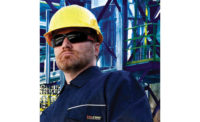
For industrial sites where workers may be exposed to chemicals or flying debris, selecting the appropriate personal protective equipment (PPE) is essential. However, despite the growing industry need to consolidate protective requirements in one universal product, material characteristics for face protection applications vary greatly, affecting the level of protection a product provides.
To ensure that the most applicable faceshield is selected for each environment, workers at industrial sites must understand the different characteristics of existing and recently introduced faceshield materials. For manufacturers of PPE, focusing on material specification early in the development of a faceshield can help ensure the most effective final product.
Factors for material consideration
Material considerations for face protection applications include safety, visibility and durability. Any change in the surface of a protective faceshield, such as marring due to chemical contact or scratches caused by projectile debris, can impair vision. As a result, the faceshield often is considered a failure, regardless of the retention of other properties. For example, a faceshield that has been hit and cracked by flying material fragments may be completely compromised due to its lack of toughness despite its remaining potential for chemical resistance. For this reason it is important to evaluate all factors including chemical, heat and scratch resistance; impact strength; toughness and optical clarity when selecting a faceshield material.
Because the types of exposures vary greatly depending on the nature of the work environment, materials also vary greatly. Materials considered for faceshields include polycarbonate (PC), cellulosics, polyethylene terephthalate glycol (PETG) and a new-generation copolyester recently introduced to the market that offers a combination of characteristics to meet the changing needs of the face protection market.
Polycarbonate
Because of its high-impact resistance, PC has long been an industry standard for face protection and is often used in protective devices in industrial and construction settings involving cutting. The toughness and durability of injection-molded or extruded-sheet PC allow it to pass American National Standards Institute (ANSI) standards at speeds of up to 300-feet-per-second, making it a viable option for ballistic and military applications in which projectile debris may come in contact with protective gear.
When exposed to moderate temperatures, PC has good heat resistance, making it a material used in applications involving welding. PC provides average scratch resistance and clarity, and faceshields made with PC can also be coated with anti-fog and anti-scratch sealants, though a primer is frequently required prior to processing. The solvent system used for the coating process can, however, cause blushing around gates and joints.
Despite its inherent impact resistance, PC provides only fair chemical resistance. When exposed to the common cleanser additive ammonium hydroxide, PC exhibits catastrophic change including whitening and loss of visibility. Likewise, heat bending of PC can result in aberrations that reduce optical clarity of the protective device.
Cellulosics
For environments such as pharmaceutical manufacturing that require faceshields with superior chemical resistance and optical clarity, cellulosics provide great advantages. Injection-molded cellulosics (propionate) and press-polished sheet (acetate) provide exceptional chemical resistance, largely because of the material’s ability to release stress caused by chemical exposure. Because the material is press-polished after extrusion, face protection applications made with cellulosics exhibit unmatched optical clarity. Cellulosic materials also have great inherent scratch resistance.
Cellulosics enable ease of processing for anti-fog and anti-scratch coatings. Special curing processes are not necessary, and anti-fog coating materials can be sprayed directly onto the cellulosic material, reducing processing times. Applications made with cellulosics are not fit, however, for environments requiring extreme impact strength or heat resistance.
PETG
Providing average chemical and impact resistance, PETG is commonly specified for faceshields used in medical shields or in environments where there is little chance of high impact. PETG is typically an affordable option that provides good optical clarity and easier cutting abilities than PC.
As a material that can only handle minimal impact, PETG does not consistently pass ANSI regulations at thinner gauges. It does, however, provide a solid option for a variety of safety applications requiring middle-of-the-road protection.
Novel copolyester
A new-generation copolyester for use in sheet or injection-molded faceshields offers superior high-impact and great chemical resistance in one product. As with PC, this new material technology allows greater durability in face protection applications, meeting ANSI 300-feet-per-second, high-impact resistance parameters. Faceshields made of this material can be used in a wide variety of environments, including refineries and laboratories, unlike faceshields developed with the previously mentioned materials.
As exemplified in image 1, the material can also withstand assembly stress and strains - including solvent and adhesive bonding; hot or cold bending and die-punching; and drilling - without significant micro-cracking. Furthermore, parts can be molded with less residual stress than PC and without a separate annealing step, thereby saving time and money. As is the case with PETG, the new chemical- and impact-resistant copolyester is easier to cut in sheet form and has greater optical clarity than PC. Also, unlike PC, the solvent used for coating processes does not cause blushing, resulting in an overall better aesthetic appeal. The novel copolyester is not, however, resistant to high temperatures, and although it allows coating application without a primer, the overall curing process is lengthier than the curing process of PC.
Material selection
Just as chemical processing and industrial grinding environments require different material characteristics for PPE, today’s PC, cellulosics, PETG and new-generation copolyesters provide various inherent strengths. Identifying the material characteristics required for each safety setting is an essential first step in selecting the ideal material for a new faceshield that keeps employees safe in the workplace.

